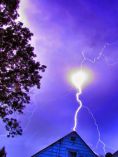When Spring Storms Threaten Your Home, Will You Be Ready?

If you're not a fan of the cold, you're probably looking forward to spring. Although spring brings warmer temperatures, it can also bring brutal thunderstorms to the Midwest that can take a toll on your house if you haven't prepared.
According to Munich Re and the Insurance Information Institute, insured losses from thunderstorms in 2015 were nearly $10 billion, which accounted for about 60% of these losses. Don't let your home become a statistic—start preparing it for spring storms as soon as the weather starts to warm up.
Start by Looking Up
Do you have big trees or branches that are close to your house? Make sure those branches are trimmed back so they are not hitting the roof or siding. You also don't want dead branches to break loose in heavy winds—they could become destructive. In addition, branches close to your house could hang down and obstruct your gutters.
Speaking of gutters, you need to make sure your gutters and downspouts are clear of leaves and debris (like a bird's nest, for example) that can prevent water from running off the roof. Also be sure the gutters and downspouts did not develop any cracks or holes over the winter. This will keep them from doing their job, which is to direct water away from the foundation.
While you're looking up, do a visual inspection of your roof to check for loose shingles that could blow away in high winds. In fact, it's a good idea to get your roof inspected each year. After all, the worst time to find out about a problem with your roof is during or after a storm. By then, a leak could develop and cause interior damage that you have to get fixed in addition to getting your roof fixed. Speaking of interior damage, a visual inspection of your walls and ceilings can tell you if you have a leak. Yellow outlines on walls, mold or mildew, or a sagging ceiling are telltale signs of a problem.
Bring the Outdoors In
When spring's warmer temperatures arrive, you generally bring out the bird feeders, wind chimes, patio furniture, grill, etc. that you put away for winter. But if a storm is forecast, you should bring all those things back inside because they can become flying debris in heavy winds.
Prepare for a Power Outage
Spring storms often result in power outages. Usually the outages are temporary, but you should always prepare for them to be longer. If one occurs in the evening you will need light, so keep candles on hand (and something to light them with) or a flashlight and plenty of batteries. In addition, it's a good idea to stock up on non-perishable foods, get a battery-operated radio with working batteries, charge all cell phones ahead of time, turn your refrigerator to its lowest setting so food will stay cold longer, have plenty of ice on hand in coolers, get plenty of bottled water and make sure your first aid kit is stocked.
Check Your Coverage
Most homeowners insurance policies cover damage from hail, wind and lightning, but not damage from a flood—flood insurance usually has to be purchased separately. Talk with your insurance agent to learn more about sheltering your home from the storm.
-
Lightning Safety Quiz
 Test Yourself
Test YourselfIs it safe to take a shower when there’s lightning in the area? Is it safe to be on the phone? See if you answered these questions—and more—correctly with our lightning safety quiz.
-
Lightning Strike Protection
 Get Prepped
Get PreppedIt’s rare, but lightning can strike your house, and if that happens, it can cause a lot of damage. Being prepared is the best defense and can save you a lot of money.
-
Power Trip
 Get Tips
Get TipsDid something trip a breaker, or did you just lose power due to a storm? Either way, we can shed some light on how to make a power outage more bearable.
